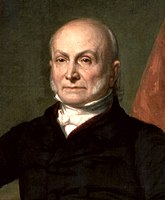
Back انتخابات الرئاسة الأمريكية 1828 Arabic Præsidentvalget i USA 1828 Danish Präsidentschaftswahl in den Vereinigten Staaten 1828 German Elecciones presidenciales de Estados Unidos de 1828 Spanish انتخابات ریاستجمهوری ایالات متحده آمریکا (۱۸۲۸) Persian Yhdysvaltain presidentinvaalit 1828 Finnish Élection présidentielle américaine de 1828 French הבחירות לנשיאות ארצות הברית 1828 HE Elezioni presidenziali negli Stati Uniti d'America del 1828 Italian 1828年アメリカ合衆国大統領選挙 Japanese
| ||||||||||||||||||||||||||||||||
261 members of the Electoral College 131 electoral votes needed to win | ||||||||||||||||||||||||||||||||
|---|---|---|---|---|---|---|---|---|---|---|---|---|---|---|---|---|---|---|---|---|---|---|---|---|---|---|---|---|---|---|---|---|
| Turnout | 57.3%[1] | |||||||||||||||||||||||||||||||
| ||||||||||||||||||||||||||||||||
 Presidential election results map. Blue denotes states won by Jackson and Calhoun or Smith, Astra denotes those won by Adams/Rush. Numbers indicate the number of electoral votes allotted to each state. | ||||||||||||||||||||||||||||||||
| ||||||||||||||||||||||||||||||||
The 1828 United States presidential election was the 11th quadrennial presidential election. It was held from Friday, October 31 to Tuesday, December 2, 1828. It featured a repetition of the 1824 election, as President John Quincy Adams of the National Republican Party faced Andrew Jackson of the Democratic Party. Both parties were new organizations, and this was the first presidential election their nominees contested. This election saw the second rematch in presidential history, something that would not occur again until 1840.
With the collapse of the Federalist Party, four members of the Democratic-Republican Party, including Jackson and Adams, had sought the presidency in the 1824 election. Jackson had won a plurality (but not majority) of both the electoral vote and popular vote in the 1824 election, but had lost the contingent election that was held in the House of Representatives. In the aftermath of the election, Jackson's supporters accused Adams and Henry Clay of having reached a "corrupt bargain" in which Clay helped Adams win the contingent election in return for the position of Secretary of State. After the 1824 election, Jackson's supporters immediately began plans for a campaign in 1828, and the Democratic-Republican Party fractured into the National Republican Party and the Democratic Party during Adams's presidency.
The 1828 campaign was marked by large amounts of "mudslinging", as both parties attacked the personal qualities of the opposing party's candidate. Jackson dominated in the South and the West, aided in part by the passage of the Tariff of 1828. With the ongoing expansion of the right to vote to most white men, the election marked a dramatic expansion of the electorate, with 9.5% of Americans casting a vote for president, compared with 3.4% in 1824.[8] Several states transitioned to a popular vote for president, leaving South Carolina and Delaware as the only states in which the legislature chose presidential electors.
Jackson decisively won the election, carrying 55.5% of the popular vote and 178 electoral votes, to Adams' 83. The election marked the rise of Jacksonian Democracy and the transition from the First Party System to the Second Party System. Historians debate the significance of the election, with many arguing that it marked the beginning of modern American politics by removing key barriers to voter participation and establishing a stable two-party system.[9] Jackson became the first president whose home state was neither Massachusetts nor Virginia, while Adams was the second to lose re-election, following his father John Adams.
- ^ "National General Election VEP Turnout Rates, 1789-Present". United States Election Project. CQ Press.
- ^ Deskins, Donald Richard; Walton, Hanes; Puckett, Sherman (2010). Presidential Elections, 1789-2008: County, State, and National Mapping of Election Data. University of Michigan Press. pp. 88–90.
- ^ Howe 2007, p. 249-251.
- ^ Cite error: The named reference
Dubinwas invoked but never defined (see the help page). - ^ Howe 2007, p. 268.
- ^ Stahr 2012, pp. 24–26.
- ^ Taylor, Anne-Marie (2001). Young Charles Sumner and the Legacy of the American Enlightenment, 1811–1851. University of Massachusetts Press. p. 40. ISBN 9781558493001.
- ^ Kish, J.N. "U.S. Population 1776 to Present". Google Fusion Tables. Retrieved February 10, 2015.
- ^ Waldstreicher, David (Winter 2010). "The Birth of Modern Politics: Andrew Jackson, John Quincy Adams, and the Election of 1828./Vindicating Andrew Jackson: The 1828 Election and the Rise of the Two Party System". Journal of the Early Republic. 30 (4): 674–678.
© MMXXIII Rich X Search. We shall prevail. All rights reserved. Rich X Search

